ECO mode TOYOTA AYGO 2014 Owners Manual (in English)
[x] Cancel search | Manufacturer: TOYOTA, Model Year: 2014, Model line: AYGO, Model: TOYOTA AYGO 2014Pages: 372, PDF Size: 14.28 MB
Page 4 of 372
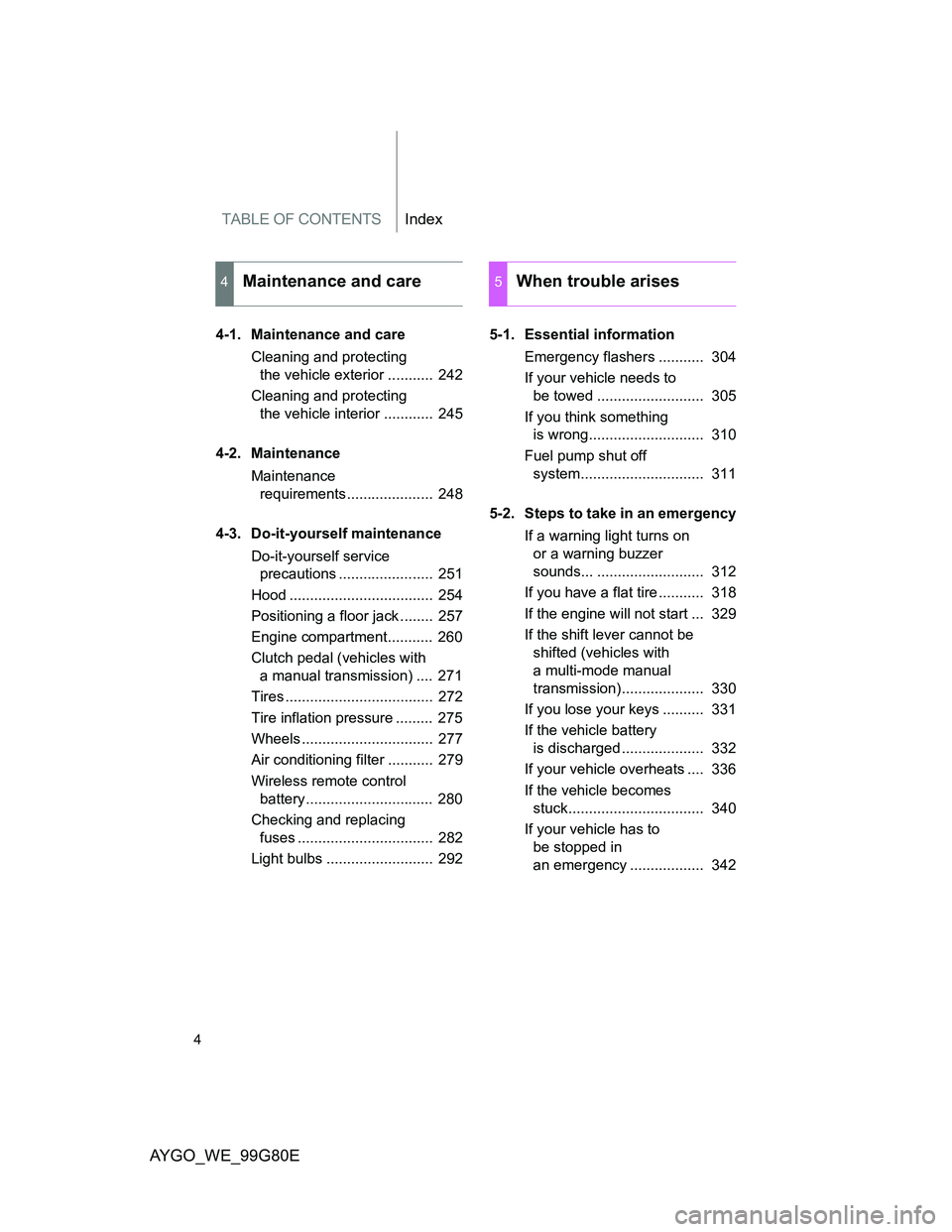
TABLE OF CONTENTSIndex
AYGO_WE_99G80E
4
4-1. Maintenance and care
Cleaning and protecting
the vehicle exterior ........... 242
Cleaning and protecting
the vehicle interior ............ 245
4-2. Maintenance
Maintenance
requirements..................... 248
4-3. Do-it-yourself maintenance
Do-it-yourself service
precautions ....................... 251
Hood ................................... 254
Positioning a floor jack ........ 257
Engine compartment........... 260
Clutch pedal (vehicles with
a manual transmission) .... 271
Tires .................................... 272
Tire inflation pressure ......... 275
Wheels ................................ 277
Air conditioning filter ........... 279
Wireless remote control
battery............................... 280
Checking and replacing
fuses ................................. 282
Light bulbs .......................... 2925-1. Essential information
Emergency flashers ........... 304
If your vehicle needs to
be towed .......................... 305
If you think something
is wrong............................ 310
Fuel pump shut off
system.............................. 311
5-2. Steps to take in an emergency
If a warning light turns on
or a warning buzzer
sounds... .......................... 312
If you have a flat tire ........... 318
If the engine will not start ... 329
If the shift lever cannot be
shifted (vehicles with
a multi-mode manual
transmission).................... 330
If you lose your keys .......... 331
If the vehicle battery
is discharged .................... 332
If your vehicle overheats .... 336
If the vehicle becomes
stuck................................. 340
If your vehicle has to
be stopped in
an emergency .................. 342
4Maintenance and care5When trouble arises
Page 28 of 372
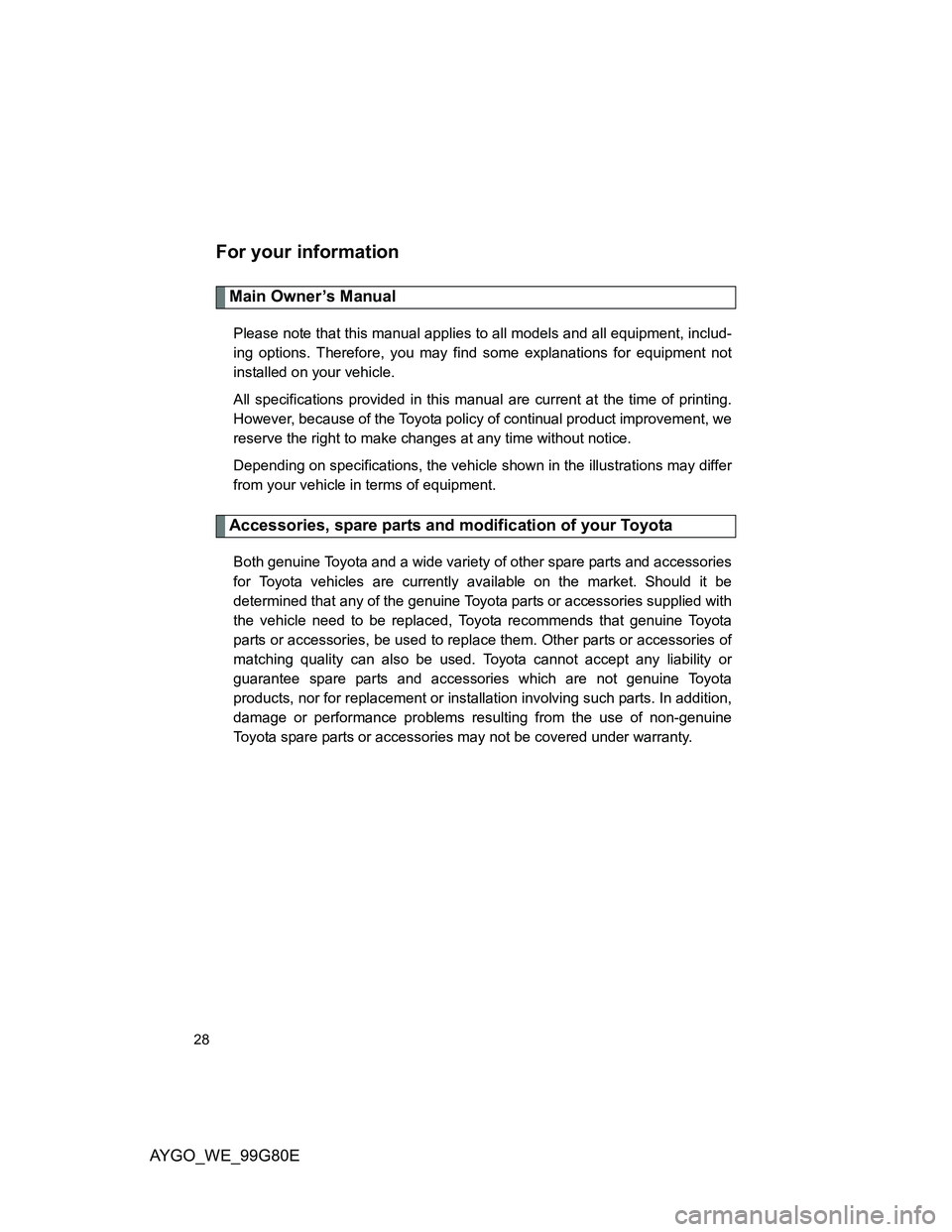
AYGO_WE_99G80E
28
For your information
Main Owner’s Manual
Please note that this manual applies to all models and all equipment, includ-
ing options. Therefore, you may find some explanations for equipment not
installed on your vehicle.
All specifications provided in this manual are current at the time of printing.
However, because of the Toyota policy of continual product improvement, we
reserve the right to make changes at any time without notice.
Depending on specifications, the vehicle shown in the illustrations may differ
from your vehicle in terms of equipment.
Accessories, spare parts and modification of your Toyota
Both genuine Toyota and a wide variety of other spare parts and accessories
for Toyota vehicles are currently available on the market. Should it be
determined that any of the genuine Toyota parts or accessories supplied with
the vehicle need to be replaced, Toyota recommends that genuine Toyota
parts or accessories, be used to replace them. Other parts or accessories of
matching quality can also be used. Toyota cannot accept any liability or
guarantee spare parts and accessories which are not genuine Toyota
products, nor for replacement or installation involving such parts. In addition,
damage or performance problems resulting from the use of non-genuine
Toyota spare parts or accessories may not be covered under warranty.
Page 119 of 372
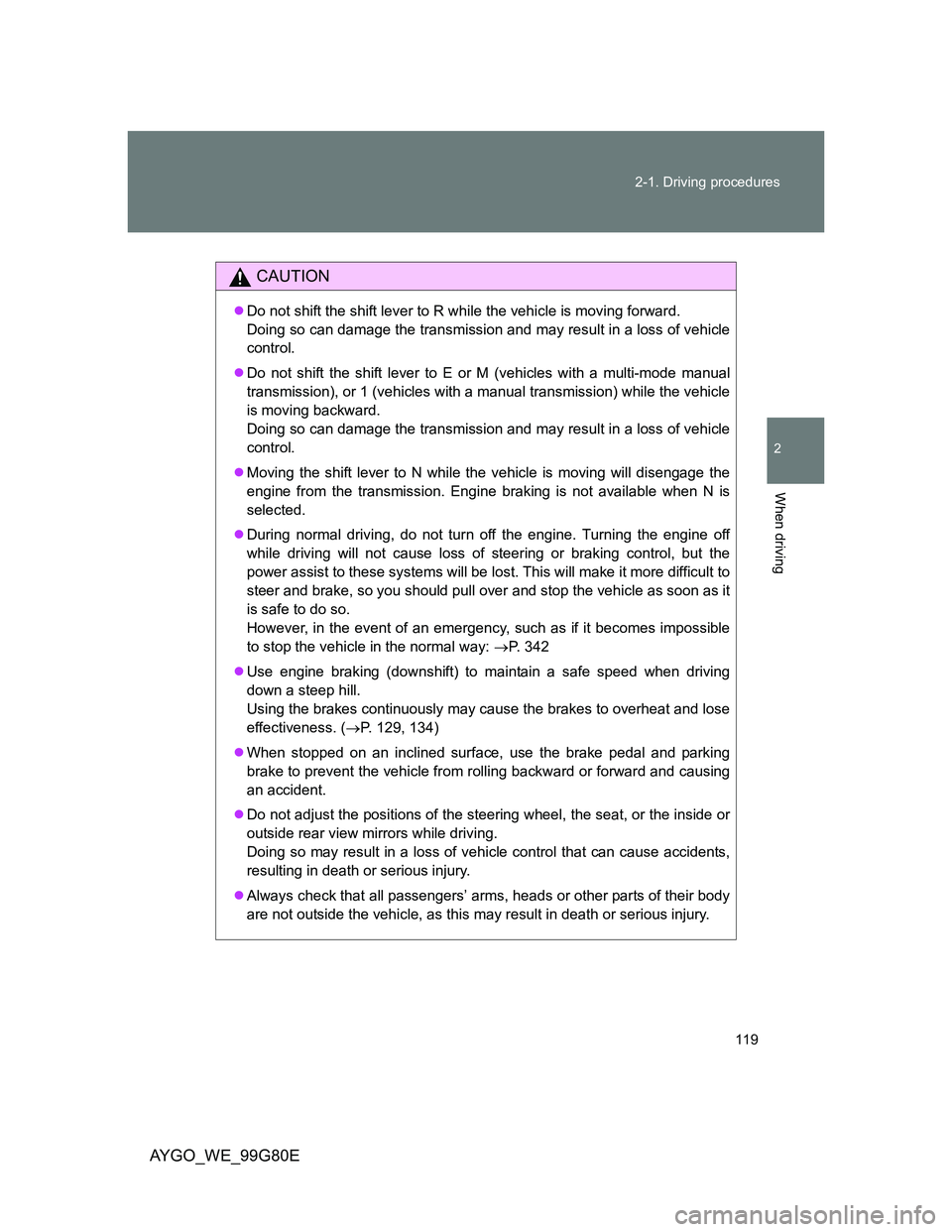
119 2-1. Driving procedures
2
When driving
AYGO_WE_99G80E
CAUTION
Do not shift the shift lever to R while the vehicle is moving forward.
Doing so can damage the transmission and may result in a loss of vehicle
control.
Do not shift the shift lever to E or M (vehicles with a multi-mode manual
transmission), or 1 (vehicles with a manual transmission) while the vehicle
is moving backward.
Doing so can damage the transmission and may result in a loss of vehicle
control.
Moving the shift lever to N while the vehicle is moving will disengage the
engine from the transmission. Engine braking is not available when N is
selected.
During normal driving, do not turn off the engine. Turning the engine off
while driving will not cause loss of steering or braking control, but the
power assist to these systems will be lost. This will make it more difficult to
steer and brake, so you should pull over and stop the vehicle as soon as it
is safe to do so.
However, in the event of an emergency, such as if it becomes impossible
to stop the vehicle in the normal way: P. 342
Use engine braking (downshift) to maintain a safe speed when driving
down a steep hill.
Using the brakes continuously may cause the brakes to overheat and lose
effectiveness. (P. 129, 134)
When stopped on an inclined surface, use the brake pedal and parking
brake to prevent the vehicle from rolling backward or forward and causing
an accident.
Do not adjust the positions of the steering wheel, the seat, or the inside or
outside rear view mirrors while driving.
Doing so may result in a loss of vehicle control that can cause accidents,
resulting in death or serious injury.
Always check that all passengers’ arms, heads or other parts of their body
are not outside the vehicle, as this may result in death or serious injury.
Page 133 of 372
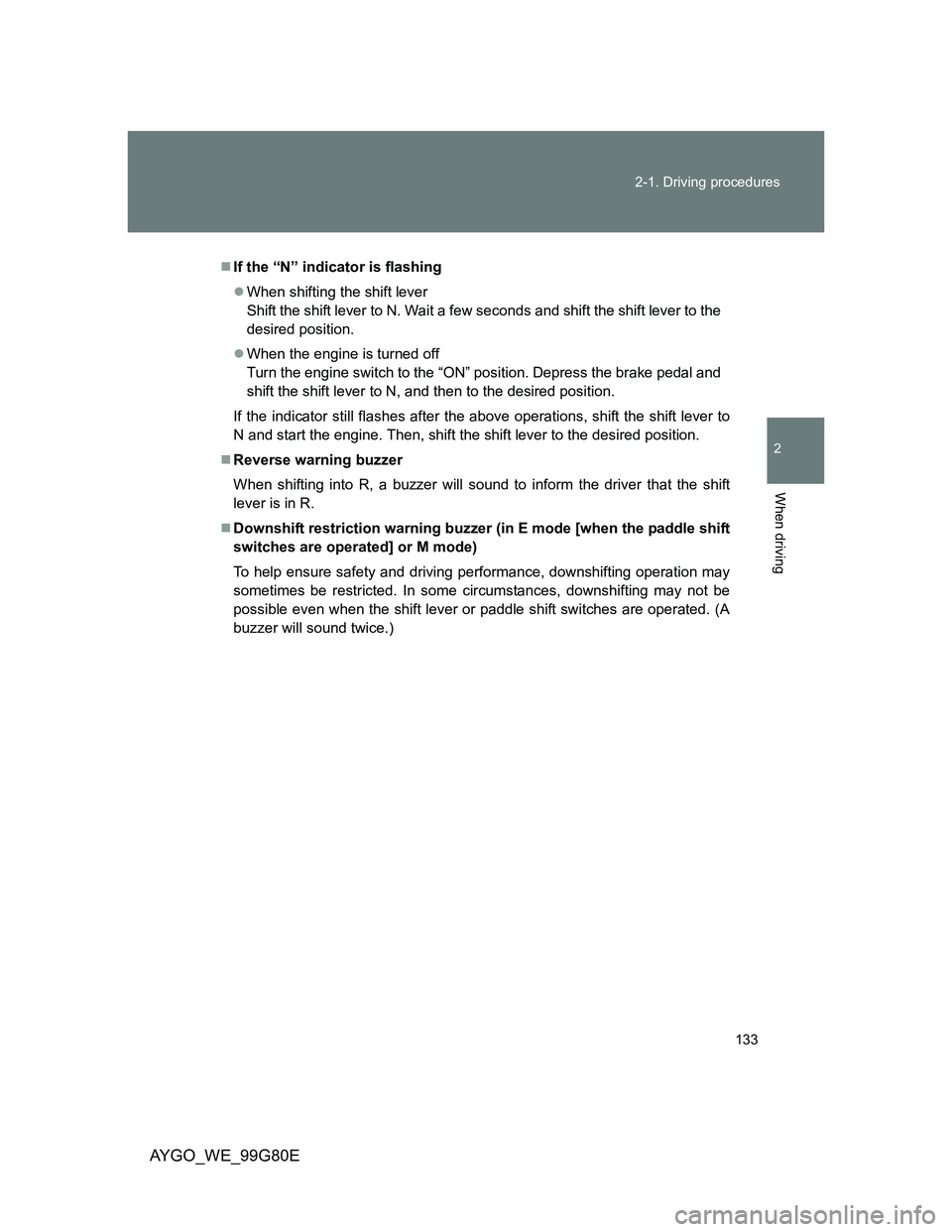
133 2-1. Driving procedures
2
When driving
AYGO_WE_99G80E
If the “N” indicator is flashing
When shifting the shift lever
Shift the shift lever to N. Wait a few seconds and shift the shift lever to the
desired position.
When the engine is turned off
Turn the engine switch to the “ON” position. Depress the brake pedal and
shift the shift lever to N, and then to the desired position.
If the indicator still flashes after the above operations, shift the shift lever to
N and start the engine. Then, shift the shift lever to the desired position.
Reverse warning buzzer
When shifting into R, a buzzer will sound to inform the driver that the shift
lever is in R.
Downshift restriction warning buzzer (in E mode [when the paddle shift
switches are operated] or M mode)
To help ensure safety and driving performance, downshifting operation may
sometimes be restricted. In some circumstances, downshifting may not be
possible even when the shift lever or paddle shift switches are operated. (A
buzzer will sound twice.)
Page 142 of 372
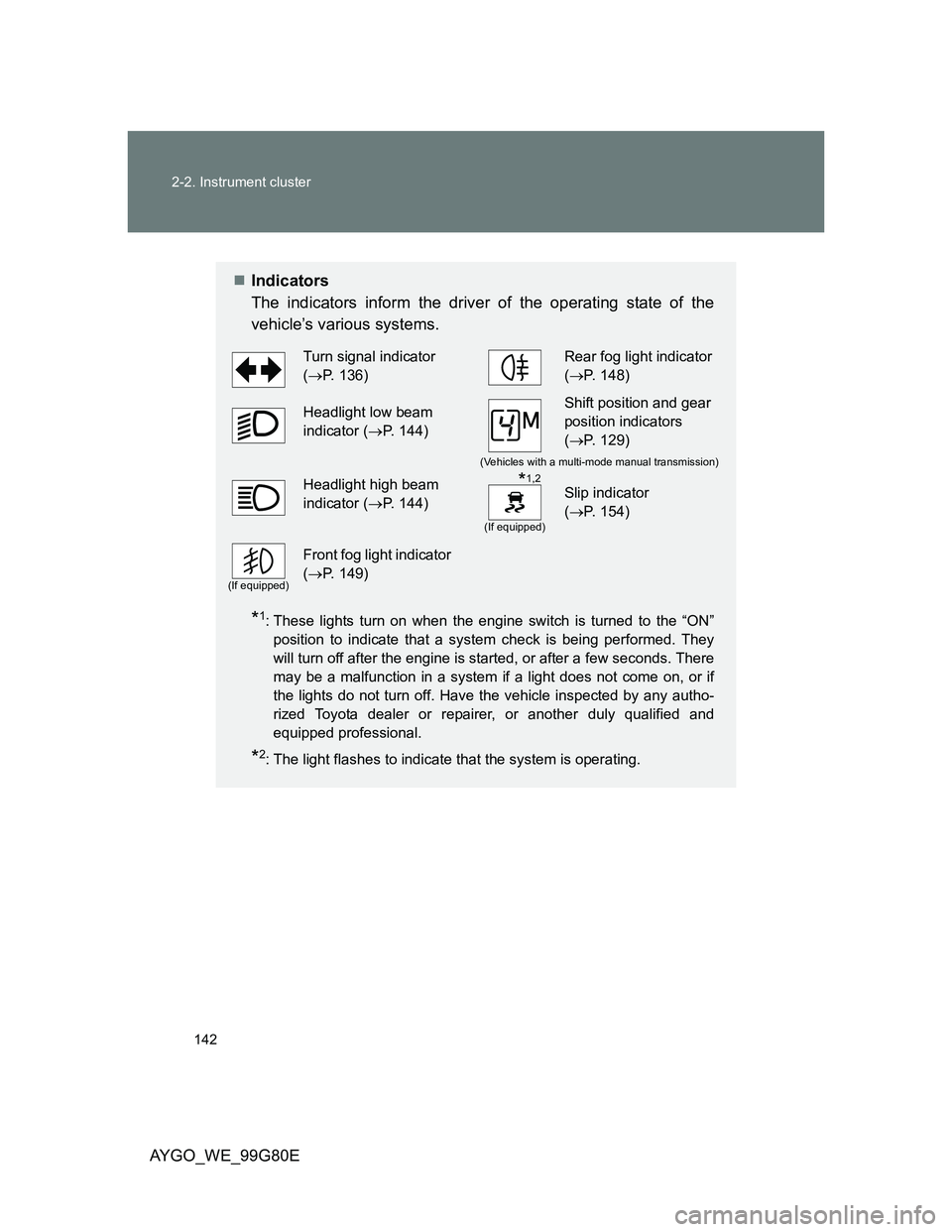
142 2-2. Instrument cluster
AYGO_WE_99G80E
Indicators
The indicators inform the driver of the operating state of the
vehicle’s various systems.
*1: These lights turn on when the engine switch is turned to the “ON”
position to indicate that a system check is being performed. They
will turn off after the engine is started, or after a few seconds. There
may be a malfunction in a system if a light does not come on, or if
the lights do not turn off. Have the vehicle inspected by any autho-
rized Toyota dealer or repairer, or another duly qualified and
equipped professional.
*2: The light flashes to indicate that the system is operating.
Turn signal indicator
(P. 136)Rear fog light indicator
(P. 148)
Headlight low beam
indicator (P. 144)Shift position and gear
position indicators
(P. 129)
Headlight high beam
indicator (P. 144)
(Vehicles with a multi-mode manual transmission)
*1,2
(If equipped)
Slip indicator
(P. 154)
(If equipped)
Front fog light indicator
(P. 149)
Page 173 of 372
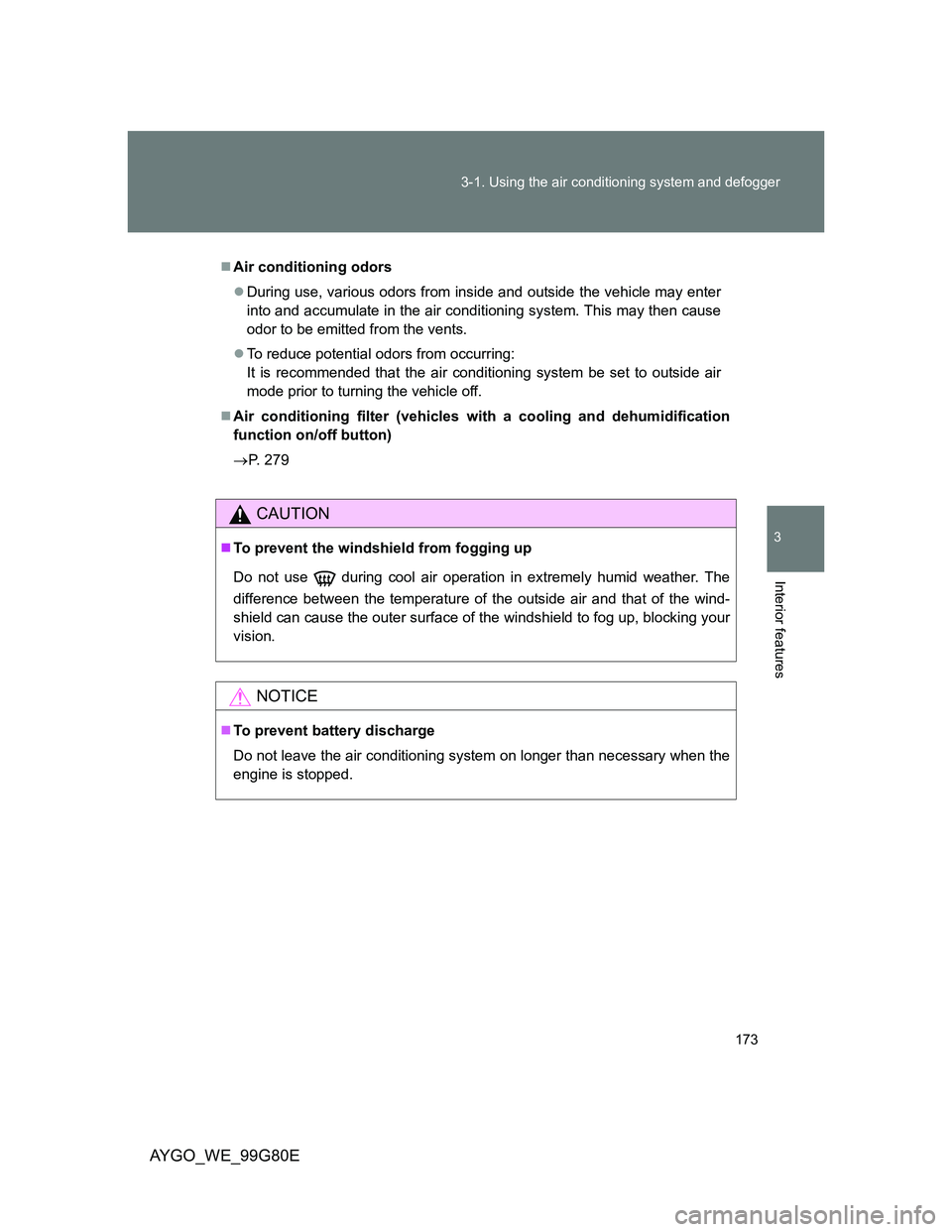
173 3-1. Using the air conditioning system and defogger
3
Interior features
AYGO_WE_99G80E
Air conditioning odors
During use, various odors from inside and outside the vehicle may enter
into and accumulate in the air conditioning system. This may then cause
odor to be emitted from the vents.
To reduce potential odors from occurring:
It is recommended that the air conditioning system be set to outside air
mode prior to turning the vehicle off.
Air conditioning filter (vehicles with a cooling and dehumidification
function on/off button)
P. 279
CAUTION
To prevent the windshield from fogging up
Do not use during cool air operation in extremely humid weather. The
difference between the temperature of the outside air and that of the wind-
shield can cause the outer surface of the windshield to fog up, blocking your
vision.
NOTICE
To prevent battery discharge
Do not leave the air conditioning system on longer than necessary when the
engine is stopped.
Page 178 of 372
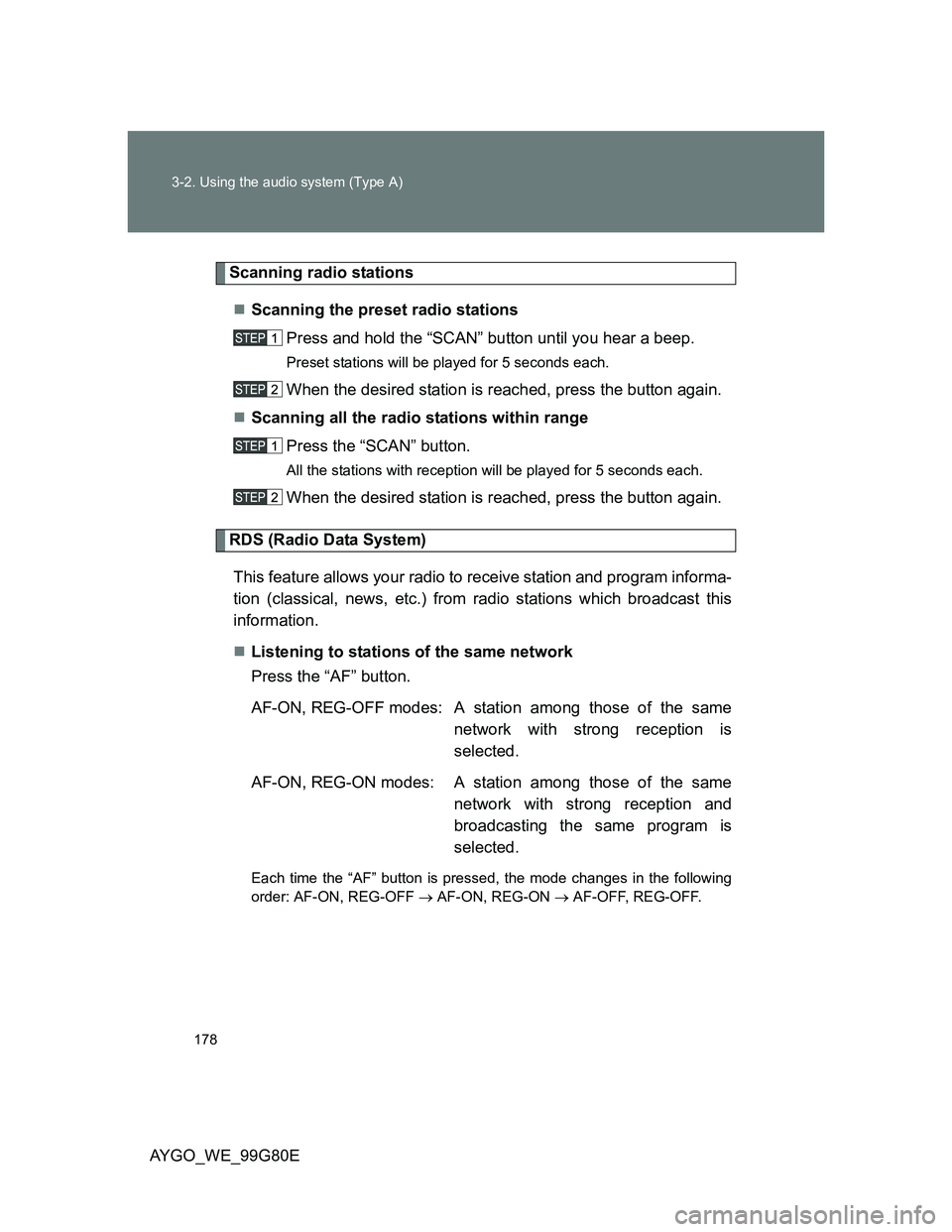
178 3-2. Using the audio system (Type A)
AYGO_WE_99G80E
Scanning radio stations
Scanning the preset radio stations
Press and hold the “SCAN” button until you hear a beep.
Preset stations will be played for 5 seconds each.
When the desired station is reached, press the button again.
Scanning all the radio stations within range
Press the “SCAN” button.
All the stations with reception will be played for 5 seconds each.
When the desired station is reached, press the button again.
RDS (Radio Data System)
This feature allows your radio to receive station and program informa-
tion (classical, news, etc.) from radio stations which broadcast this
information.
Listening to stations of the same network
Press the “AF” button.
AF-ON, REG-OFF modes: A station among those of the same
network with strong reception is
selected.
AF-ON, REG-ON modes: A station among those of the same
network with strong reception and
broadcasting the same program is
selected.
Each time the “AF” button is pressed, the mode changes in the following
order: AF-ON, REG-OFF AF-ON, REG-ON AF-OFF, REG-OFF.
Page 206 of 372
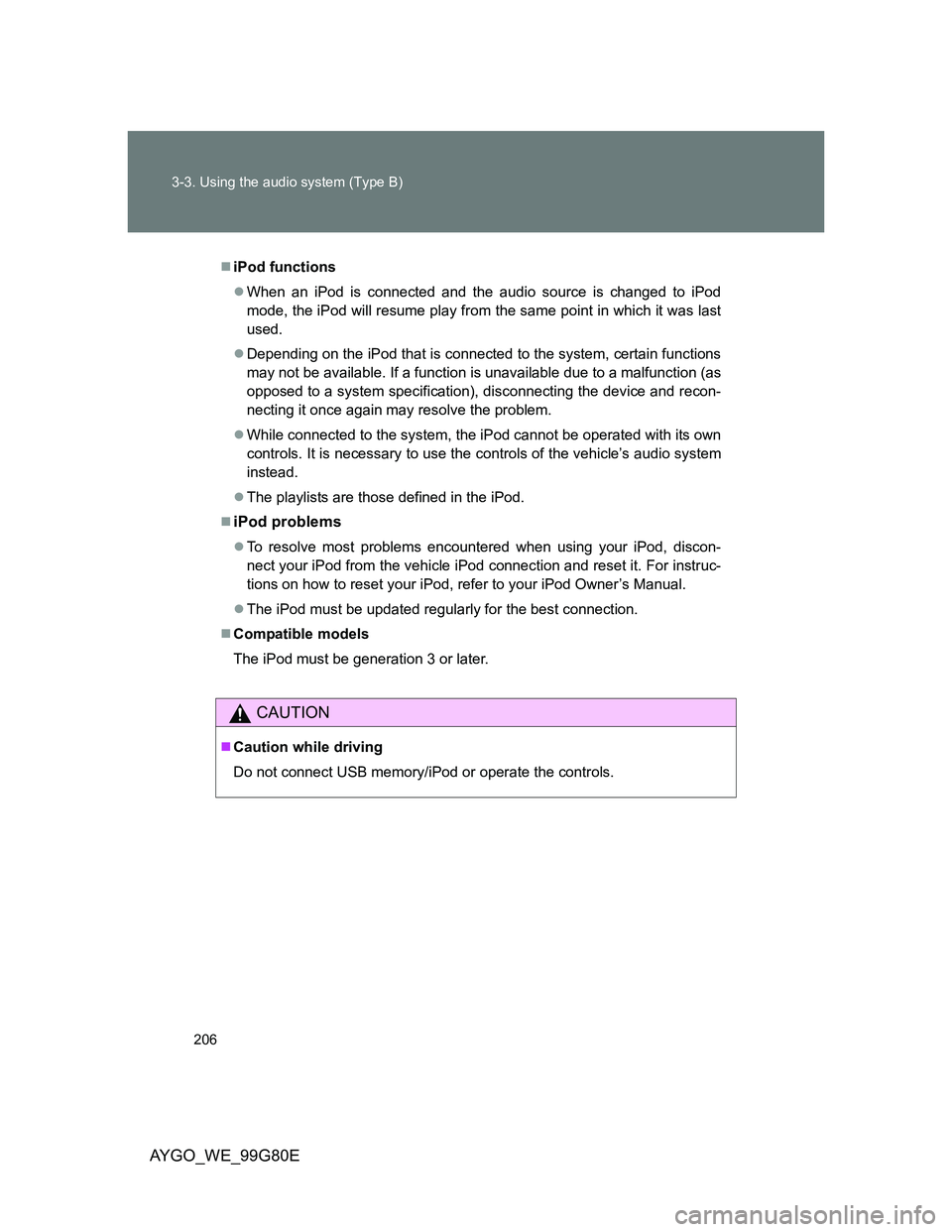
206 3-3. Using the audio system (Type B)
AYGO_WE_99G80E
iPod functions
When an iPod is connected and the audio source is changed to iPod
mode, the iPod will resume play from the same point in which it was last
used.
Depending on the iPod that is connected to the system, certain functions
may not be available. If a function is unavailable due to a malfunction (as
opposed to a system specification), disconnecting the device and recon-
necting it once again may resolve the problem.
While connected to the system, the iPod cannot be operated with its own
controls. It is necessary to use the controls of the vehicle’s audio system
instead.
The playlists are those defined in the iPod.
iPod problems
To resolve most problems encountered when using your iPod, discon-
nect your iPod from the vehicle iPod connection and reset it. For instruc-
tions on how to reset your iPod, refer to your iPod Owner’s Manual.
The iPod must be updated regularly for the best connection.
Compatible models
The iPod must be generation 3 or later.
CAUTION
Caution while driving
Do not connect USB memory/iPod or operate the controls.
Page 225 of 372
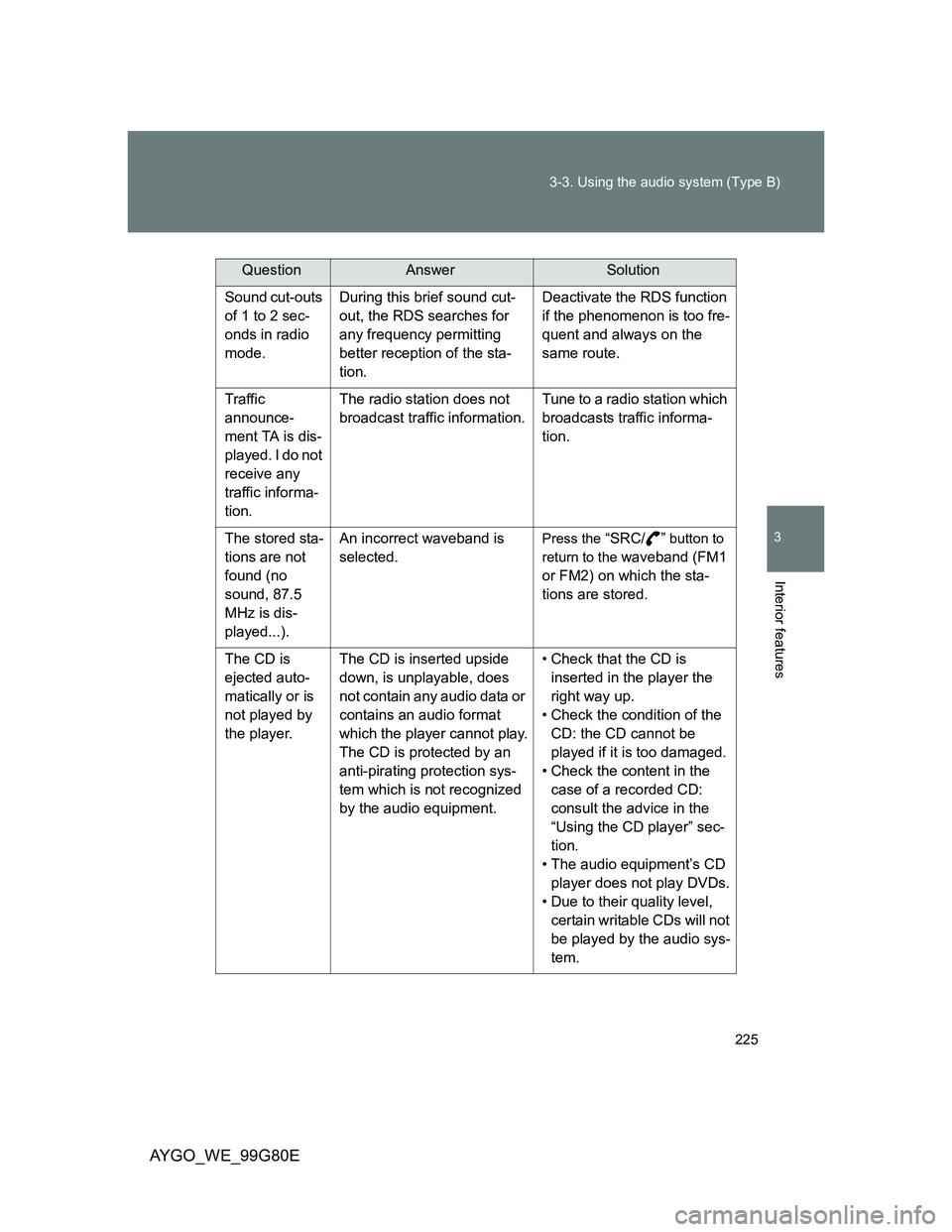
225 3-3. Using the audio system (Type B)
3
Interior features
AYGO_WE_99G80E
Sound cut-outs
of 1 to 2 sec-
onds in radio
mode.During this brief sound cut-
out, the RDS searches for
any frequency permitting
better reception of the sta-
tion.Deactivate the RDS function
if the phenomenon is too fre-
quent and always on the
same route.
Traffic
announce-
ment TA is dis-
played. I do not
receive any
traffic informa-
tion.The radio station does not
broadcast traffic information.Tune to a radio station which
broadcasts traffic informa-
tion.
The stored sta-
tions are not
found (no
sound, 87.5
MHz is dis-
played...).An incorrect waveband is
selected.Press the “SRC/ ” button to
return to the
waveband (FM1
or FM2) on which the sta-
tions are stored.
The CD is
ejected auto-
matically or is
not played by
the player.The CD is inserted upside
down, is unplayable, does
not contain any audio data or
contains an audio format
which the player cannot play.
The CD is protected by an
anti-pirating protection sys-
tem which is not recognized
by the audio equipment.• Check that the CD is
inserted in the player the
right way up.
• Check the condition of the
CD: the CD cannot be
played if it is too damaged.
• Check the content in the
case of a recorded CD:
consult the advice in the
“Using the CD player” sec-
tion.
• The audio equipment’s CD
player does not play DVDs.
• Due to their quality level,
certain writable CDs will not
be played by the audio sys-
tem.
QuestionAnswerSolution
Page 227 of 372
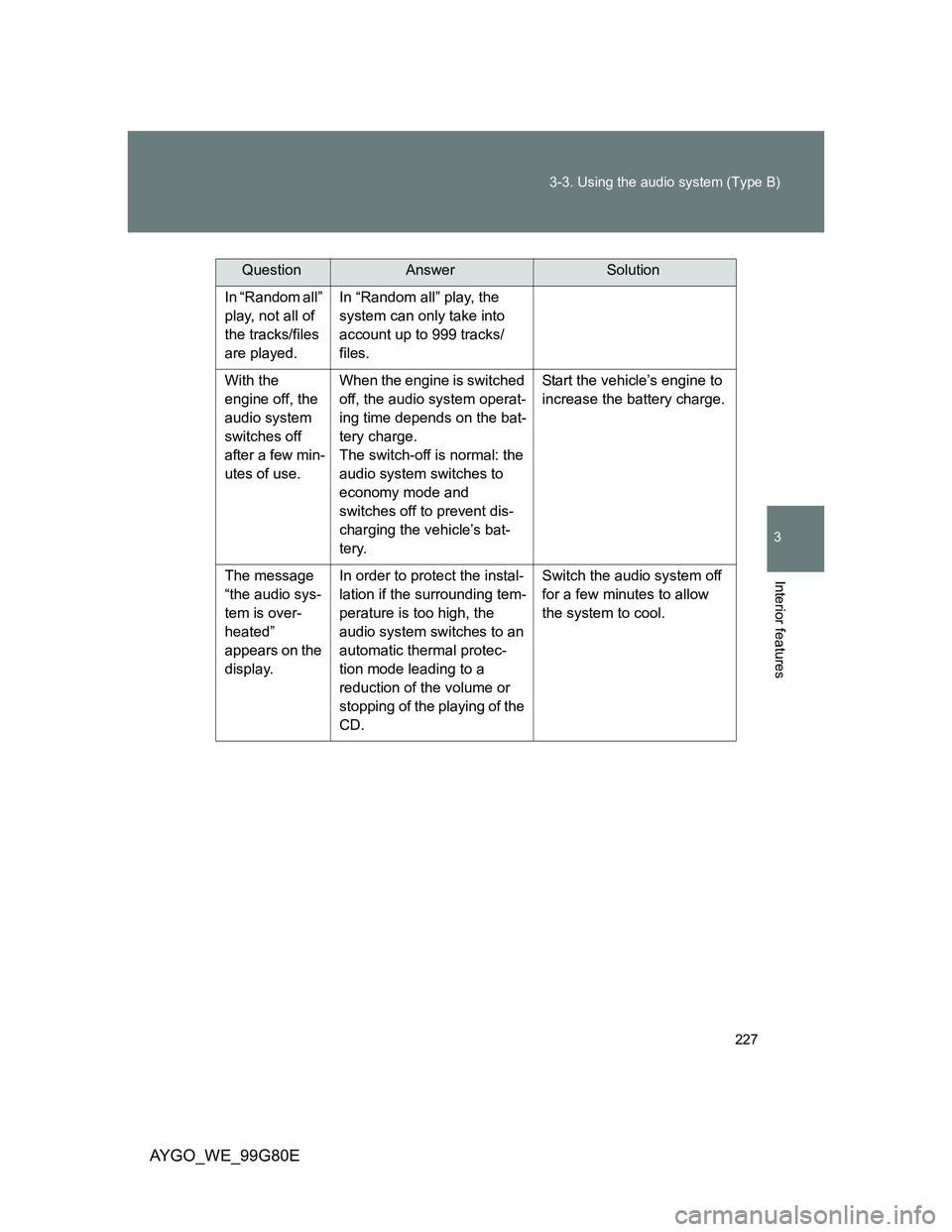
227 3-3. Using the audio system (Type B)
3
Interior features
AYGO_WE_99G80E
In “Random all”
play, not all of
the tracks/files
are played.In “Random all” play, the
system can only take into
account up to 999 tracks/
files.
With the
engine off, the
audio system
switches off
after a few min-
utes of use.When the engine is switched
off, the audio system operat-
ing time depends on the bat-
tery charge.
The switch-off is normal: the
audio system switches to
economy mode and
switches off to prevent dis-
charging the vehicle’s bat-
tery.Start the vehicle’s engine to
increase the battery charge.
The message
“the audio sys-
tem is over-
heated”
appears on the
display.In order to protect the instal-
lation if the surrounding tem-
perature is too high, the
audio system switches to an
automatic thermal protec-
tion mode leading to a
reduction of the volume or
stopping of the playing of the
CD.Switch the audio system off
for a few minutes to allow
the system to cool.
QuestionAnswerSolution